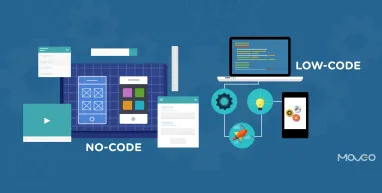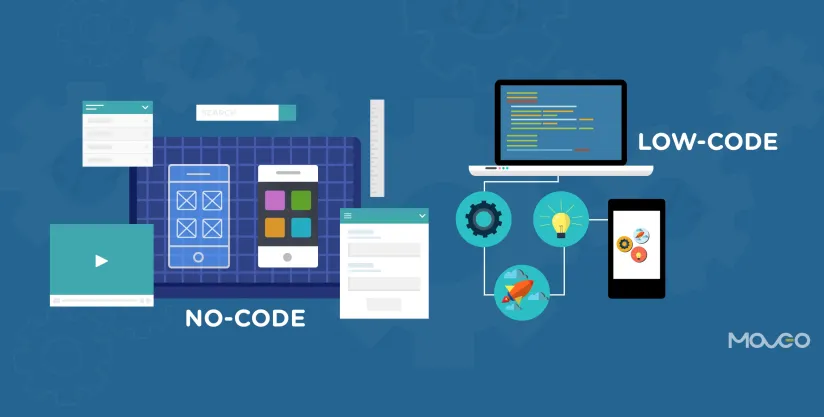Low/No-Code RPA Software in 2024: Benefits & Best Practices


As of 2021, most RPA solutions require a time-consuming programming process, which is mostly (63%) outsourced to consulting companies, system integrators, or niche RPA implementation companies.
This programming process needs to be repeated every time there are changes in the process which makes RPA maintenance complex. How can business leaders embrace RPA without worrying about bot maintenance?
A new crop of companies is tackling this problem. Developing low code and no code RPA solutions are enabling businesses to enjoy RPA benefits in a faster and cheaper manner.
What are low-code and no-code RPA?
No code RPA solutions aim to completely reduce the need to code for RPA. While most common RPA tools have been offering UX support for a long time, the UX of common RPA tools tends to be rather restrictive and developers mostly rely on programming to automate processes. In addition to no-code solutions, there are also low code RPA solutions that require limited/simple programming compared to traditional RPA software.
What are different RPA tools in terms of UI?
We mainly see 3 types of vendors in the space:
1. Code-based RPA
These are RPA tools where end-users rely on coding (e.g. in Python) to build bots. The primary benefits of code-based RPA bots are their flexibility and customizability. Programming languages are powerful tools to formulate how bots will work.
However, the downside is that code-based RPA tools are not targeted at citizen developers. They are instead meant to be built by developers with programming skills. Therefore, business users will need to rely on developers for building or maintaining bots. This results in a slower process and in inefficiencies as domain experts and developers need to communicate to clarify the specifications for the bot.
2. Low-code RPA
Most RPA companies fall under this bucket. Low-code RPA is a solution where the solution has 2 user interfaces:
- Simple processes can be automated by a drag & drop user interface or by recording a user’s activities.
- Users can code bots to automate complex processes.
They are intended to be used by citizen developers to automate everyday employee tasks, such as Excel operations, automated email replies, or report creation, among other use cases. For complex tasks, citizen developers can get the support of developers or develop their own technical skills to finalize bot building.
3. No-code RPA
Some newer RPA companies claim to be no-code. But almost all RPA solutions allow users to access the RPA code, therefore the difference between no-code or low-code solutions is not clear. We recommend users test RPA tools by automating a process that they choose. This helps them understand its ease of use and not get confused by marketing jargon.
However, for more complex bots, relying on citizen developer-led RPA may fall short. Complex bots may involve automating high-scale activities of multiple departments, incorporating complex controls and regular maintenance to keep up with changing systems and processes.
For such cases, citizen developers may get support from the tech team or ramp up their coding skills to use code-based interfaces of low-code/no-code RPA tools to build solutions.
Learn more about the types of RPA.
What are the benefits of no-code RPA?
Due to the need to program RPA automation, companies need to:
- train their personnel or hire/outsource resources who will program RPA tools
- wait for long programming and debugging phases
- reprogram the automation with every change in the process, relying on outsourced resources or a limited number of trained personnel
Therefore, no code RPA provides the following benefits:
- Programming takes significantly shorter and becomes simpler
- Enabling in-house resources can take on more responsibilities
- Therefore, simplifying the maintenance of RPA bots
Though these are substantial benefits, this approach is not a silver bullet. Users still need to understand and map out existing processes which can be a time-consuming process.
Learn more about the benefits of no code technology.
What are the best practices for no-code/low-code RPA bots?
1. Code quality
No-code user interfaces involve the manipulation of visual elements like boxes and connectors. Though these visual elements may not seem like software code, they are building blocks of the bot. Therefore, their quality (e.g. simplicity, understandability) is important.
Maintaining a poorly documented, complex bot with a no-code interface would be harder than maintaining a well-built code-based RPA bot.
Sponsored:
Develop, run, and manage software robots using Argos Labs’ no-code RPA. The main feature that sets Argos Labs apart from competitors is their POT SDK toolset, that is open-source and Python-compatible. Benefits of using Argos Lab’s RPA include:
- Fully customizable low-code platform to meet customers’ needs
- Affordable license schemes for different business needs
- Entry level engineers and citizen developers can run the tools
2. Keeping RPA and process know-how in house
It is hard to improve someone else’s bot no matter how well it is written. Companies can set up Centers of Excellence (CoEs) and identify process experts to ensure that RPA and process knowledge remain in-house.
3. Process intelligence
Bots need to be maintained as processes or systems change. The better you understand your processes, the better you can understand the implications of process changes and the easier you can maintain your bots. Process intelligence provides insights that will guide to implementation phase.
For more, please read our RPA implementation best practices article.
Further readings
To learn more about no-code technology, read:
And to learn more about RPA and its use cases, read:
To explore RPA in detail, feel free to download our in-depth whitepaper on the topic:
And if you believe your business will benefit from an RPA solution, feel free to scroll down our comprehensive list of RPA tools and automation software and solutions.
And let us guide you through the process of finding the right solution:
Featured image source

Cem has been the principal analyst at AIMultiple since 2017. AIMultiple informs hundreds of thousands of businesses (as per similarWeb) including 60% of Fortune 500 every month.
Cem's work has been cited by leading global publications including Business Insider, Forbes, Washington Post, global firms like Deloitte, HPE, NGOs like World Economic Forum and supranational organizations like European Commission. You can see more reputable companies and media that referenced AIMultiple.
Throughout his career, Cem served as a tech consultant, tech buyer and tech entrepreneur. He advised businesses on their enterprise software, automation, cloud, AI / ML and other technology related decisions at McKinsey & Company and Altman Solon for more than a decade. He also published a McKinsey report on digitalization.
He led technology strategy and procurement of a telco while reporting to the CEO. He has also led commercial growth of deep tech company Hypatos that reached a 7 digit annual recurring revenue and a 9 digit valuation from 0 within 2 years. Cem's work in Hypatos was covered by leading technology publications like TechCrunch and Business Insider.
Cem regularly speaks at international technology conferences. He graduated from Bogazici University as a computer engineer and holds an MBA from Columbia Business School.
To stay up-to-date on B2B tech & accelerate your enterprise:
Follow on
Comments
Your email address will not be published. All fields are required.